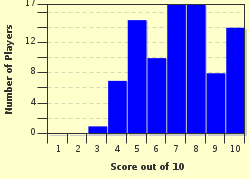Quiz Answer Key and Fun Facts
1. Jason Alexander holds Td Th against one other player and the flop comes Jd 5d 2d. Alexander bets out and his opponent raises all-in. A call will cost him more than half of his stack. Is a call statistically a good play in this situation?
2. Jason Alexander holds Td Th against one other player and the flop comes Jd 5d 2d. The turn brings the Jh. The board now reads Jd 5d 2d Jh. Alexander checks and his opponent pushes all-in. A call will cost him more than half of his stack. Is a call statistically a good play in this situation?
3. In this hand you hold Kh Kd in the small blind. The player under the gun pushes all-in for 9,850. A player in middle position re-raises all-in for 51,425. The action folds back around to you. You decide to fold saying to your opponent, "You've got to have Aces." If you think your opponent has Aces is folding the statistically correct play?
4. Mark Landgraf holds Ac Qd and the flop comes Kh Qh Qs. His opponent has pushed all-in. Is a call statistically a good play in this hand?
5. Alexander Yaroshetskiy holds Ah Jh and the flop comes Kh Qh Qs. His opponent has pushed all-in. Is a call statistically a good play in this hand?
6. Davis Bowen holds 2s 2d and the board reads Ah 2c 9s Ts. Bowen calls all-in on the turn. Is this a statistically good call?
7. Brandon Garrity holds 9d 7d with a flop of 10d 9h Ad. His opponent moved all-in for 18,000. The pot now stands at over 36,000. Garrity has a stack of 70,000. Is calling a correct play statistically in this situation taking into consideration his chip stack and the pot odds?
8. Jeffrey Lisandro has 125,000 in his stack and and the average chip stack is around 40,000 to 45,000. He holds Ac Ah in late position with a flop of Qh 7s Th. The small blind(SB) bets 3,100 of his 21,100 into a pot of 1,500 and a player in middle position(MP) pushes all-in for 6,875. Lisandro moves all-in trying to isolate against the MP. Was Lisandro's all-in a statistically wise play considering the pot size and Lisandro's chip stack?
9. You are holding 8d 7d and the board reads Jd Td Th. Your opponent has moved all-in. Is calling here statistically a good play?
10. Patrik Danzer holds 8h 9h and the board reads 5s 7h Ah Th Jh. Danzer has a straight flush but does he have the nuts? (The nuts is an unbeatable hand.)
Source: Author
tazman6619
This quiz was reviewed by FunTrivia editor
DakotaNorth before going online.
Any errors found in FunTrivia content are routinely corrected through our feedback system.

